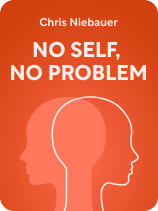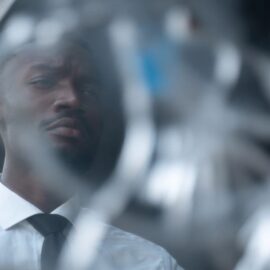

This article is an excerpt from the Shortform book guide to "No Self, No Problem" by Chris Niebauer. Shortform has the world's best summaries and analyses of books you should be reading.
Like this article? Sign up for a free trial here.
Have you ever questioned the nature of your own identity? What if everything you believe about yourself is just an illusion?
No Self, No Problem, a book by neuroscientist Chris Niebauer, challenges our understanding of self-identity. He argues that our sense of self is merely a construct created by our brain’s left hemisphere. This concept aligns with ancient Eastern philosophies that have long questioned the existence of a fixed self.
Prepare to explore the fascinating intersection of neuroscience and spirituality as we delve into an overview of this thought-provoking book.
Overview of No Self, No Problem
Think about what you’ve done so far today: Maybe you woke up to sunlight coming in through your window, took a quick shower, picked up an espresso at the coffee shop, and settled in at the office for a productive workday. From the time you woke up to the present moment, the “you” who has observed the world, felt emotions, had thoughts, and made decisions has felt like the same person: one with a consistent set of preferences, values, and memories. But No Self, No Problem, a book by neuroscientist Chris Niebauer published in 2019, contends that not only is the “you” who felt happy to see it was sunny or chose dark roast over blonde roast less consistent than you think, but that self might not really exist at all—except as an illusion.
Niebauer, who earned a Ph.D. in Neuropsychology and teaches at Slippery Rock University in Pennsylvania, explains that Eastern traditions such as Buddhism have long taught that the self isn’t as real as it seems and only exists in our thoughts. Niebauer says neuroscience is getting close to proving this idea. He states that studies mapping what happens in the right brain versus the left brain have begun to show the self doesn’t exist in the brain at all. Instead, it seems to be an illusion conjured by your brain and enabled by your natural (but mistaken) sense that your passing thoughts, feelings, and judgments come from a permanent “you.”
While having a stable sense of self helps you make sense of the world, Niebauer contends that staying too attached to this illusion can make you anxious and miserable. He writes that most people are held captive by the constant monologue of their left brain. But if you learn to tap into the more intuitive ways of knowing enabled by your right brain, you can detach yourself from your thoughts and feelings. Then, you can see them for what they are: subjective observations and judgments you don’t have to take so seriously.
We’ll first look at how the Western idea of the self differs from the idea of the self as people understand it in the East. Then, we’ll explore Niebauer’s insight that neuroscience can show us why we believe in a stable “self” and expose how our brains create this illusion. We’ll also consider why and how you might want to change how you perceive yourself and your place in the world.
What Do We Believe About the Self?
Your sense of self (and your ideas about how real and persistent that “self” really is) make up a fundamental part of how you see the world. You don’t come up with these ideas in a vacuum: Niebauer explains that you learn them from the culture you’re raised in. We’ll compare the Western idea of the self to the Eastern idea of the self, as Niebauer explains them, and consider what it might mean to find a compromise between these two worldviews in your perception of yourself.
In the West, People Believe in a Self That Thinks and Acts
Niebauer states Western philosophy makes some foundational assumptions about the self: People raised in the West learn that the self is real, it’s continuous over time, and it’s the “doer” behind our thoughts, feelings, decisions, and actions. In the West, thinking is considered a central part of the self. Niebauer says most people in the West implicitly assume that the self is the part of the mind engaged in explaining our experiences and narrating our thoughts. For centuries, Western philosophy has linked the act of thinking to our very being: We know we exist precisely because we can think (and notice ourselves thinking). This means that in the West, having a self who thinks, judges, and decides is considered a vital part of being human.
Along with the idea of the thinking self goes the idea that the self also persists, seemingly unchanged, over time. Niebauer points out that you perceive yourself as the same person day in and day out, with a consistent set of values and inclinations and a distinct personality. In other words, you feel you’re the same person today as you were yesterday—and the day before that, and the day before that.
Throughout the book, Niebauer contends that the Western sense of the self as real is deceptive—but he acknowledges it’s hard to fathom the idea of existing without a self. That’s in part because your sense of self feels inextricably linked to your sense of agency, and it seems to drive your decisions. Because of your perception that the self is in the driver’s seat and doing the navigating, you can think about drinking your morning espresso or writing a report at work and feel certain it’s “you” who did those things. (If not you, then who was it?)
In the East, People Learn to Regard the Self as Just an Illusion
Unlike people raised in the West, people who view the world through the lens of Eastern schools of thought—like Buddhism, Taoism, or the Advaita Vedanta school of Hinduism—learn a very different concept of the self. Niebauer explains these schools of thought teach thatthe self is only an illusion: an impermanent idea we have to loosen our grip on if we want to see reality as it actually is.
According to several schools of Eastern thought, you don’t really have a self that exists in any real sense because the self as you perceive it is just a product of your thoughts. Niebauer explains that this means the self isn’t really the “thinker” you feel it is. Your thoughts appear in your consciousness, and you think your “self” produces or directs them. But it’s actually the other way around, and your sense of self comes from your thoughts. In other words, the self is no more real or durable than the thoughts that you think and forget from moment to moment. Niebauer explains that to Eastern ways of thinking, holding onto the illusion of the self obscures more lucid ways of perceiving who you are and what you experience in the world.
A Buddhist teaching that Niebauer characterizes as crucial to the Eastern idea of the self is a concept called anatta, or “no self.” Niebauer explains that anatta means we have no permanent self, and the self only exists when we’re thinking about it. Buddhists contend that a belief in a stable self is not only erroneous but also leads to all of the suffering we experience in our lives. That’s because it makes us feel invested in thoughts, feelings, and judgments, which are all just temporary.
Is It Possible to Reconcile These Two Worldviews?
The concept that the self isn’t real might be difficult to wrap your head around. But according to Niebauer, this idea is increasingly finding support in research where neuroscientists explore how the brain perceives reality and how its two halves work together to create your unique interpretation of the world.
Niebauer explains that once you understand how your brain creates the illusion of the self (and why this illusion is so convincing), then you can work to look beyond it. Learning to loosen your grip on your sense of self doesn’t require you to make radical changes, like completely letting go of your sense of self or living your life like a Buddhist monk. Instead, Niebauer says you can just learn to take your “self” less seriously, finding something of a compromise between the Western and Eastern ideas of the self.
Why Do We Believe in the Self If It Isn’t Real?
In Niebauer’s assessment, neuroscience is finally catching up to what Buddhist teachers discovered thousands of years ago about the nature of the self: that it isn’t real. We’ll examine what new research suggests about how the brain constructs your sense of self, using the unique capabilities of its left hemisphere and right hemisphere to convince you that you have a real and permanent self. Then, we’ll explore Niebauer’s argument that these scientific studies reveal that your self-concept doesn’t correspond to something real or permanent—just like Eastern thinkers have taught for thousands of years.
First, a Crash Course in Brain Anatomy
Before we dive into how your brain constructs your sense of self and convinces you it’s real, it’s important to know that the brain consists of a left hemisphere (the “left brain”) and a right hemisphere (the “right brain”). The two communicate with each other via a bundle of nerve fibers called the corpus callosum, which runs between them. Each side of the brain looks like a mirror image of the other. But neuroscientists have learned the two are actually quite different: Each side of the brain has a different set of capabilities, and certain cognitive tasks rely more strongly on one side of the brain than the other.
The left brain and the right brain each make a unique contribution to your belief in your sense of self, and Niebauer suggests the self is just a story that your narrative-driven left brain continuously weaves. But if you can step away from the narratives your left brain constructs, you can tap into your right brain—the part of your brain that experiences the world in real time—and realize you have no consistent “self” at all, just experiences happening in the present moment.
The Left Brain Creates the Self by Building Stories From Our Experiences
The left brain works to make sense of the world. Niebauer explains that it creates a continuous story to explain what we experience, how we behave, and who we are. This story creates our sense of self. Telling a story involves building sequences and categories of events and information. So the left brain is often thinking about what happened in the past and what might occur in the future, rather than living in the present.
Niebauer explains that, to fit everything we know about ourselves and our lives into a comprehensive narrative, the left brain constantly works to explain what’s going on, what we’re doing, and what we’re thinking. The left brain comes up with a story to explain what it observes, even when it has absolutely no idea why things are the way they are. Niebauer explains that it’s also completely convinced the explanations it comes up with are correct, even when they aren’t based on reality and in fact often do a bad job of explaining what we observe.
According to Niebauer, the left brain has the odd tendency to fluently explain our actions even when it has no idea why we’re behaving as we are. To demonstrate how this works, he cites the example of people called “split-brain patients,” who have had their corpus callosum severed to treat severe epilepsy and reduce the intensity of the debilitating seizures it causes. When the right brain of a split-brain patient follows instructions the left brain can’t access, the left brain doesn’t admit it doesn’t know why the person is completing an action. Instead, it invents (and believes) a story to explain the behavior.
The Right Brain Lives In the Present Moment—But the Left Brain Doesn’t
While the left brain is constantly talking to itself—judging, sequencing, categorizing, and labeling everything we experience—the right brain approaches reality differently. Niebauer states that the right brain experiences the world without the constraints of language because while it understands language, it can’t produce language. Instead, the right half of your brain perceives the world more directly, without the filter of the left half’s narratives.
Niebauer explains that the right brain and the left brain are constantly sharing what they’re learning and doing. The left brain does this in words, which gives you the ability to consciously think about what you’re doing. But Niebauer notes that, because the right brain can’t “speak” to the left brain in words, it leaves the left brain in the dark as to what it’s doing. So the left brain labels many of the activities of the nonverbal right brain “unconscious,” even ones that involve choice and complex thinking.
While the right brain’s ability to think and act without language creates some odd effects in its collaboration with the left, it comes with benefits, too. Niebauer explains that the right brain’s ability to think without the constraints of verbal language gives us several kinds of nonverbal knowledge: intuition, emotions, plus a more holistic way of making sense of the world than the narrative-based method of the left brain.
Is the Left Brain or the Right Brain Correct? Why Does It Matter?
The evidence is looking pretty compelling that there’s a difference between your left brain and your right brain’s visions of the world. The left brain’s efforts to make sense of the world create your sense of self, and the right brain’s way of thinking pokes some big holes in the left brain’s story. But, is that enough to throw out the narrative altogether? Niebauer contends another key piece of evidence from neuroscience research seems to rule out the existence of the self as an objective reality—and to show that believing the self is real causes us suffering we don’t have to experience.
While neuroscientists have identified regions of the left brain and right brain that seem to be responsible for specific tasks, Niebauer states that one region that so far remains conspicuously absent from our map of the brain is a center for the self. One crucial quality unites the cognitive functions—like language, face perception, or understanding others’ emotions—neuroscientists have mapped to specific parts of the brain: Because these cognitive tasks depend in part on specific brain regions, they seem to be performed the same way each time. Niebauer argues the task of creating the self isn’t consistent in the same way.
Niebauer argues that the fact that neuroscientists haven’t discovered a brain region responsible for our sense of self seems to confirm that the self doesn’t persist over time (or even exist in the brain) in the way we feel it does. He explains that in this way, neuroscience suggests the individual self isn’t a stable reality but instead is just an idea—just as Buddhism and other Eastern schools of thought have taught for thousands of years.
Niebauer also hypothesizes that consciousness, like the self, might not really exist in the brain, either: Instead, your brain might participate in a kind of “universal consciousness” present in all of us. Niebauer explains that just as we accept the illusion that we have a permanent and individual self, we also take it for granted that we have an individual consciousness, with our own perceptions and memories. But by holding on to these ideas, we prevent ourselves from entertaining the possibility that consciousness might not be something we have, but something we participate in, along with everyone else in the world.
So why does all of this matter? Niebauer explains accepting the self as real isn’t a harmless error, but often makes us anxious, unhappy, or dissatisfied in our lives. He notes that when we identify our sense of self (and our sense of reality) too strongly with our thoughts, feelings, and judgments, then we take those thoughts and feelings too literally.
When we believe what we’re thinking or feeling is literally true, then we assume that thoughts like, “I can’t do anything right,” or “Things will never work out the way I want” tell us something true or real about the world. So we experience what Buddhists call “suffering.” Suffering involves a sense of dissatisfaction with the way things are, either in the world around us or in our inner worlds. We experience it so much that it feels like an inescapable part of life.
Niebauer contends that, by working to loosen your grip on your traditional idea of the self, you can work toward the freedom from suffering that countless students of Buddhism have sought. And you can do that while still enjoying the ups and downs of daily life lived from the perspective of the self you’ve always known.
How Can You Change Your Perception of Yourself?
It’s one thing to know that believing too strongly that your thoughts and feelings are real—and that they create a sense of self that’s really “you”—is an error. It’s another thing to figure out how to go about changing the way you’ve always perceived reality. Fortunately, Niebauer can help. In the book, he provides a variety of short exercises and prompts to kickstart this process. We’ll explore three of the most important strategies he recommends focusing on if you want to learn to take the stories of your left brain a little less seriously and build a happier life in the process.
Realize That Your “Self” Is Just an Illusion
The first step to letting go of the narrative your left brain constructs for you is simply to realize that the “self” you think you know (and are) is just an illusion. Seeing this illusion for what it is can help free you from the constraints of the identity you’ve built for yourself. This means you’ll be able to approach your life with more flexibility, adaptability, and openness to new experiences.
Niebauer points out that, once you understand that your sense of self is just an illusion, rather than something fixed and stable, you can realize the same thing applies to other people, too. It’s easy to stereotype people or to think you know what their personalities or tendencies are. But other people’s characters and inner lives are as complex and ever-changing as your own thoughts, emotions, behaviors, and temperament. Niebauer explains that knowing nobody else has a fixed self can help you practice empathy for others and feel grateful for what you experience with the people you love, without the burden of rigid expectations for what kind of person the other should be.
Learn That You Aren’t Your Thoughts or Feelings
Niebauer explains that coming to understand the narrative of the “self” as an illusion can also set you on a path toward discovering one of the core insights of mindfulness: the idea that you aren’t your thoughts or feelings.
According to Niebauer, if you can let go of the tendency to identify yourself with what you’re thinking or feeling, then you can observe your thoughts and emotions from a distance instead of accepting them as real. Then you can learn to handle them more objectively, which can reduce the stress and anxiety you feel in your everyday life. He recommends practicing mindfulness to cultivate the skill of being awake to everything you’re experiencing in the present moment, without trying to judge it, apply labels to it, or fit it into a neat narrative about yourself or the world. Rather than getting lost in past memories or future anxieties, you can strive to have lucid moments where you’re just experiencing the present.
Choose the Middle Path
Niebauer explains that, once you know intellectually that the self is an illusion, you can choose among three paths. The first path leads you right back to the status quo, where you identify yourself with the voice in your head and let your left brain tell you what story to believe about yourself and your world. At the other extreme, the second path leads you to a life filled with meditation training, mindfulness practice, yoga instruction, and prayer, where you dedicate your time to using these tools to try to transcend your narrative-based way of seeing the world.
The third path is what Buddhists call the middle path because it offers a compromise between the other two. Niebauer says that when you take this path, you still live your life letting your left brain construct its narratives and make its judgments. But you also cultivate the ability to take those stories less seriously. Likewise, while you might practice meditation, mindfulness, or yoga to exercise the muscle of seeing things with your right brain rather than your left, you also spend time just living your everyday life.
Choosing the middle path, as Niebauer describes it, is like allowing yourself to get caught up in a captivating novel, even though you know it’s just a story. From time to time, you’ll lose yourself in the action and feel the joys and disappointments of your life deeply. Other times, you’ll remember they’re all part of the story your left brain tells. You’ll be able to step back and watch as if from a distance, experiencing everything that comes your way without clinging too strongly to your left brain’s judgments of events and experiencing a much calmer and more open approach to life.

———End of Preview———
Like what you just read? Read the rest of the world's best book summary and analysis of Chris Niebauer's "No Self, No Problem" at Shortform.
Here's what you'll find in our full No Self, No Problem summary:
- Why everything you know about yourself is wrong
- How science is catching on to what Eastern religions have been teaching for millenia
- How to loosen your grip on the thoughts and judgments that make you dissatisfied with your reality






